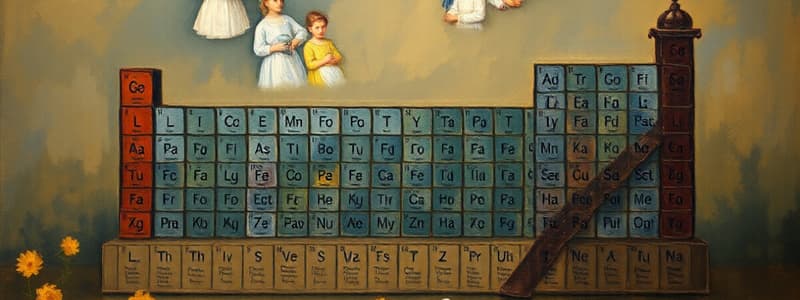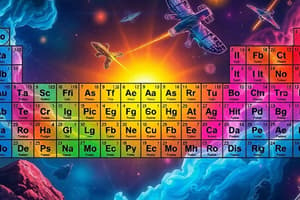Podcast
Questions and Answers
How are elements primarily organized in the periodic table?
How are elements primarily organized in the periodic table?
- By their reactivity
- By their groups and periods
- By their atomic weights
- By their atomic numbers (correct)
Which group of elements is known for being highly reactive and tends to lose one electron?
Which group of elements is known for being highly reactive and tends to lose one electron?
- Group 17 (Halogens)
- Group 2 (Alkaline Earth Metals)
- Group 18 (Noble gases)
- Group 1 (Alkali Metals) (correct)
What determines the chemical properties of an element?
What determines the chemical properties of an element?
- The number of neutrons
- The number of protons
- Its atomic number (correct)
- Its atomic weight
What characteristic distinguishes the noble gases from other groups in the periodic table?
What characteristic distinguishes the noble gases from other groups in the periodic table?
Which type of elements includes those with atomic numbers 57-71?
Which type of elements includes those with atomic numbers 57-71?
What is electronegativity primarily associated with?
What is electronegativity primarily associated with?
What is the primary factor that impacts the chemical bonds an element can make?
What is the primary factor that impacts the chemical bonds an element can make?
Which groups are regarded as alkaline earth metals?
Which groups are regarded as alkaline earth metals?
Flashcards
Element Reactivity
Element Reactivity
An element's tendency to gain or lose electrons influences how it interacts with other elements.
Periodic Table Organization
Periodic Table Organization
Elements are arranged by atomic number in the periodic table, reflecting their properties and reactivity.
Periods (periodic table)
Periods (periodic table)
Horizontal rows in the periodic table; elements in the same period have increasing atomic numbers.
Groups (periodic table)
Groups (periodic table)
Signup and view all the flashcards
Transition Metals
Transition Metals
Signup and view all the flashcards
Noble Gases
Noble Gases
Signup and view all the flashcards
Electronegativity
Electronegativity
Signup and view all the flashcards
Electronic Configuration
Electronic Configuration
Signup and view all the flashcards
Study Notes
Classification of Elements
- The video discusses the classification of elements.
- The periodic table is used to organise elements.
- Elements are arranged according to their atomic numbers.
Properties of Elements
- The properties of elements depend on their atomic weights, which determines their positions on the periodic table.
- The chemical properties of elements are directly affected by their atomic numbers.
- Elements are grouped together based on their chemical and physical properties.
Periods and Groups
- The periodic table is organized into seven horizontal rows known as periods.
- The vertical columns are called groups.
- The positions of elements within the periodic table determine their properties and reactivity.
- The groups are further subdivided into subgroups based on properties.
Chemical Properties (Reactivity)
- The reactivity of elements is primarily based on their tendency to gain or lose electrons.
- Elements in group 1 (Alkali Metals) are highly reactive, and tend to lose one electron to form cations.
- Elements in group 2 (Alkaline Earth Metals) are also reactive, and tend to lose two electrons to form cations.
- Elements in group 18 (Noble gases) are unreactive due to their full outer electron shell. They do not participate in typical chemical reactions.
Electronic Configuration
- The electronic configuration of an element determines its chemical properties.
- This configuration refers to the arrangement of electrons within an atom.
- The arrangement of electrons impacts the chemical bonds a specific element can make.
Types of Elements
- The periodic table also highlights various types of elements, including transition metals, lanthanides, and actinides.
- These classifications are based on their electronic configurations and chemical properties.
- Transition metals: Groups III-XII on the Periodic table; their properties relate to their ability to lose d-electrons.
- Lanthanides: Elements 57-71; they have similar chemistry due to their f-electrons.
- Actinides: Elements 89-103; they are radioactive and display similar characteristics due to their f-electrons.
Other important features
- The video also discusses the concept of electronegativity, which refers to an atom's ability to attract electrons.
- Electronegativity is an important factor in determining the type of chemical bond that forms between elements.
Conclusion
- The video aims to provide a simplified understanding of the periodic table and its importance in classifying elements.
- The focus is on how to utilize the periodic table to understand the properties of elements.
Studying That Suits You
Use AI to generate personalized quizzes and flashcards to suit your learning preferences.




